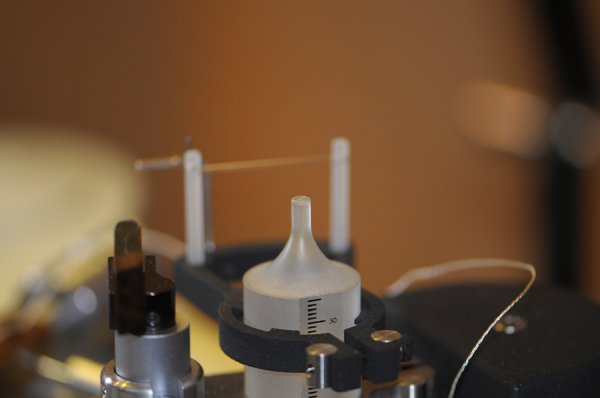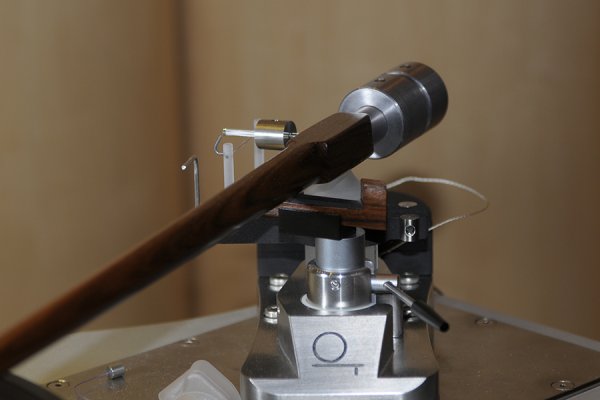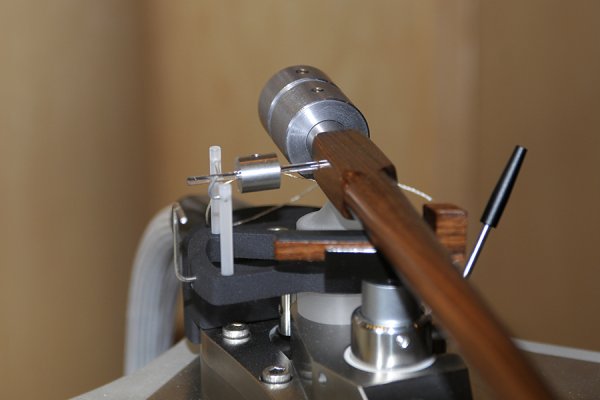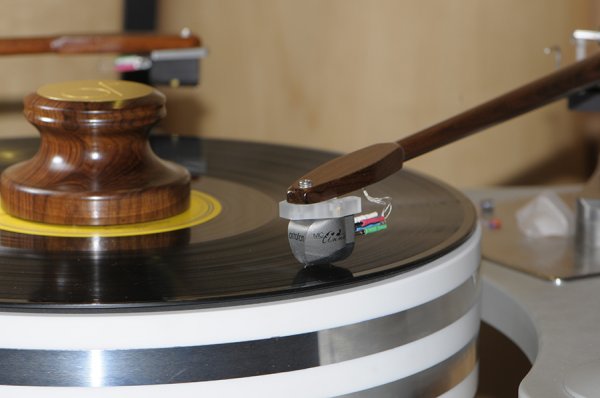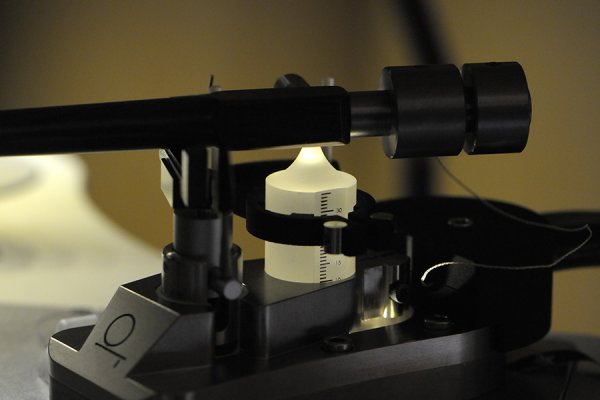Mike-I don't know who Chris is, but I'm the one that posted the pictures. I reported on other threads today that these LPs are super noisy and make them unplayable as a result. I'm bummed. If you read comments from Jazzdoc and others including Gary, there seems to be a consensus that Acoustic Sounds puts out noisy vinyl-specially the Clarity vinyl.
Review: Durand Telos Tonearm
- Thread starter jazdoc
- Start date
You are using an out of date browser. It may not display this or other websites correctly.
You should upgrade or use an alternative browser.
You should upgrade or use an alternative browser.
Mike-I don't know who Chris is, but I'm the one that posted the pictures. I reported on other threads today that these LPs are super noisy and make them unplayable as a result. I'm bummed. If you read comments from Jazzdoc and others including Gary, there seems to be a consensus that Acoustic Sounds puts out noisy vinyl-specially the Clarity vinyl.
Acoustic Sounds didn't put out the Clarity vinyl-Classic Records did
CES News:
Durand Tonearms will be at the 2012 CES and T.H.E. Show. The Talea II will be playing in two rooms:
- CES, in the Venetian Hotel; Room 29-133, on a Palmer 2.5 Turntable, with the Jan Allaerts MC1B MKII cartridge, courtesy of Sonare Coeli, in conjunction with Estelon/Alfred & Partners. Equipment will include Estelon speakers, Concert Fidelity amplification, Kubala Sosna cables, Running Springs power conditioners.
- T.H.E. Show, in the Flamingo Hotel: Valley of Fire Boardroom, the Lotus Group will have a Talea II on a Hanss T-60 turntable.
Was surprised to see that Jonathan isn't going to use the arm on the NVS turntable? Or was that just an oversight?
Durand Tonearms will be at the 2012 CES and T.H.E. Show. The Talea II will be playing in two rooms:
- CES, in the Venetian Hotel; Room 29-133, on a Palmer 2.5 Turntable, with the Jan Allaerts MC1B MKII cartridge, courtesy of Sonare Coeli, in conjunction with Estelon/Alfred & Partners. Equipment will include Estelon speakers, Concert Fidelity amplification, Kubala Sosna cables, Running Springs power conditioners.
- T.H.E. Show, in the Flamingo Hotel: Valley of Fire Boardroom, the Lotus Group will have a Talea II on a Hanss T-60 turntable.
Was surprised to see that Jonathan isn't going to use the arm on the NVS turntable? Or was that just an oversight?
Last edited:
Just a quick update to my initial review. I finally upgraded the already excellent tonearm cable to Found-Music cable. I had high expectations because of the improvements I had experienced as I added the Found-Music cable products throughout the rest of the system, but the upgrade has been a very pleasant surprise. I get the impression that this last link in the cable chain (including Found Music power cords, interconnects and speaker cables) has achieved a synergy with the downstream cabling. I now think of cabling as a system, and not a series of individual wires to be mixed and matched.
I have to agree with you on cabling as a system...I've found the same brand and same model have to best synergies...or maybe the easiest to arrive at best synergies. On your tonearm...was the original cable captive and you had to solder this ...or did the whole arm get rewired? Just curious....
I have to agree with you on cabling as a system...I've found the same brand and same model have to best synergies...or maybe the easiest to arrive at best synergies. On your tonearm...was the original cable captive and you had to solder this ...or did the whole arm get rewired? Just curious....
Scott Sheaffer of Found Music rewired the tonearm cable..
A well thought out review jazdoc you were clearly smitten with this arm at the time of writing. This thread was started nearly 2 years ago i wonder if there is any news on a Telos Mk2 or even a completely new designed arm to be released?
Mike Lavigne has the Telos with Sapphire upgrades. It pushes the performance envelope even further. I'd love to have one but college payments come first. BTW, the more time I spend with the Telos, the more performance I can squeeze of it. It's not fussy; rather, taking the time to experiment is very rewarding.
The Telos Sapphire must be incredible. Does anyone know the retail price? Does it come standard with the sapphire cartridge mounting plate?
I do think it is incredible......and every day of listening to it brings new musical insights. it simply digs deeper for musical truth, and does it with such ease and effortlessness. sure; you can check off all the boxes as it goes about it's business; but the musical whole is much more than the sum of it's parts. the subtlety and nuance of this tonearm are beyond my ability to describe.
my Telos Sapphire is a pre-production model. and as it is not in final form Joel has not yet set the price. he does expect the final form of the Telos Sapphire to come out later this year.
mine does have the Sapphire cartridge plate; however......as the final form of the Telos Sapphire is not yet firm I cannot say whether that final form will include the Sapphire cartridge plate.
my Telos Sapphire has a few other unique pieces that individually raise the performance bar. (1) the counter weights are made of the same un-obtainium metal as the Telos base instead of stainless like the stock Telos. for the NVS installation the Telos needs a spacer for the base for height; (2) my Telos Sapphire spacer is also made of the un-obtainium metal. other Telos tonearms have the bearing tower made of stainless with a Sapphire insert, and the bearing sets on top of the tip. (3) my bearing is underslung which allows for the use of a special bearing lubricant, and (4) my whole bearing tower is solid Sapphire. on the stock Telos the anti-skate bridge on the azimuth platform is made of stainless; both the posts and crossbar. (5) on mine it is all Sapphire. and (6) the azimuth post on the armwand is all Sapphire instead of stainless.
if I overlooked something I apologize.
my Telos also has an upgraded cable from Found Music, but it's not directly part of the Telos Sapphire 'pre-production' package.
I do have a completely stock Telos sitting next to the Sapphire version that I use for my Miyajima mono cartridge, and it is a wonderful tone arm.
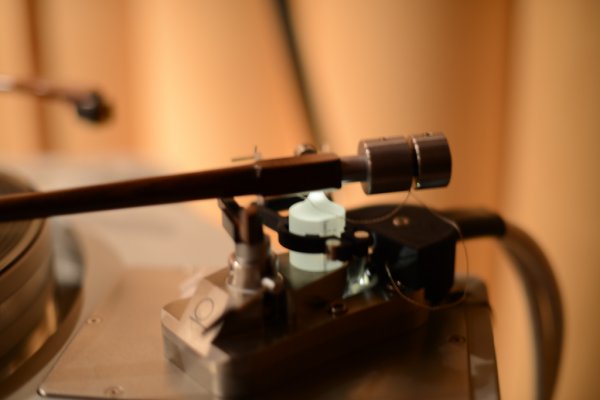
solid sapphire bearing tower, lighted from below with an LED. originally mine was red, but I preferred the white LED.
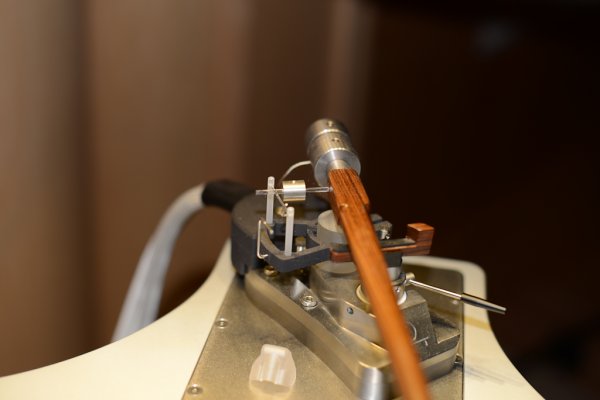
solid sapphire azimuth bridge and bar, and you can see the spacer below the tone arm base.
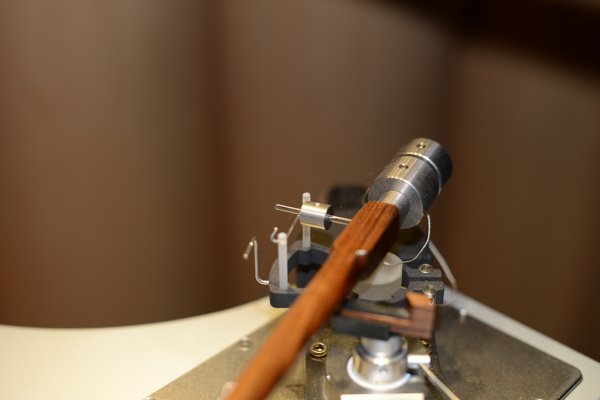
un-obtainium counter weights
Thanks Mike for the photographs and descriptions. Could you please explain again how the VTA works. I see a locking collar on the saphire bearing but I don't see how the bearing goes up and down. The locking collar looks as though it's only purpose is to support the azimuth pillars and bar/weight. It's a beautiful and deceptively simple looking design.
Thanks Mike for the photographs and descriptions. Could you please explain again how the VTA works. I see a locking collar on the saphire bearing but I don't see how the bearing goes up and down. The locking collar looks as though it's only purpose is to support the azimuth pillars and bar/weight. It's a beautiful and deceptively simple looking design.
VTA adjustment is typically the Achilles heal of any tone arm design, as it has the potential to have mechanical deficiencies that are audible. if there are multiple points of tightening and loosening, lack of robustness, and corresponding compromises in the design, you can never recover elsewhere what is lost. it may allow for easy quick adjustment, but at a cost.
the VTA adjustment for the Telos is very simple and elegant. as you observed, the clamp around the bearing tower that you see in the pictures has only to do with adjusting the height and degree of tightness of that azimuth assembly. the VTA adjustment clamp is actually part of the massive one piece base. it extends out behind the bearing tower with a cavity below it and uses a hefty allen bolt for tightness. the whole bearing tower slides up and down the sleeve in the base assembly and the bearing tower has a scale on it for precision adjustment. then there is a threaded hole in the middle of the bottom of the arm board and a tool which threads into this hole when needed to push the bearing tower up for precision adjustment. if your arm board design does not allow easy access below then one needs to grab the bearing tower and push or pull it for adjustment. not an approach for 'every pressing' different VTA. but it will deliver net gains over such designs with it's advantages to the nuance of the music.
a note; even forgetting to back off or remove the tool for height adjustment is audible. every additional degree of solidity of the bearing tower gets rewarded with a more complete musical picture.
Last edited:
VTA adjustment is typically the Achilles heal of any tone arm design, as it has the potential to have mechanical deficiencies that are audible. if there are multiple points of tightening and loosening, lack of robustness, and corresponding compromises in the design, you can never recover elsewhere what is lost. it may allow for easy quick adjustment, but at a cost.
the VTA adjustment for the Telos is very simple and elegant. as you observed, the clamp around the bearing tower that you see in the pictures has only to do with adjusting the height and degree of tightness of that azimuth assembly. the VTA adjustment clamp is actually part of the massive one piece base. it extends out behind the bearing tower with a cavity below it and uses a hefty allen bolt for tightness. the whole bearing tower slides up and down the sleeve in the base assembly and the bearing tower has a scale on it for precision adjustment. then there is a threaded hole in the middle of the bottom of the arm board and a tool which threads into this hole when needed to push the bearing tower up for precision adjustment. if your arm board design does not allow easy access below then one needs to grab the bearing tower and push or pull it for adjustment. not an approach for 'every pressing' different VTA. but it will deliver net gains over such designs with it's advantages to the nuance of the music.
a note; even forgetting to back off or remove the tool for height adjustment is audible. every additional degree of solidity of the bearing tower gets rewarded with a more complete musical picture.
Thank you Mike. Your description is easy to follow. I fully appreciate the design approach which trades off convenience for rigidity and thus hopefully performance. My SME V-12 takes a similar approach toward VTA adjustment in favor of a very solid/rigid fixed tower on which the bearing sits, though it is certainly not as simple and elegant as the Durand solution. For this reason, I don't adjust VTA for each LP. I can't say if this is the better sounding compromise, but I sure like the sound of my arm.
Those additional close-up photos of your arm on the Wake Kinetics table are wonderful. They prompt me to ask two more questions: First, the azimuth arm and weight look as though they rest on the cross bar and slide fore and aft as the arm moves toward the spindle. If this is indeed the case, is there some friction at this point, and if so, does that introduce a potential resonance into the system? Does it cause some resistance, perhaps intended, to the movement of the arm? Also, there is a vertical hook which is outside this azimuth mechanism. Is this part of the anti-skate mechanism? If so, could you describe how that works?
Thanks, and I appreciate your indulging those of us who have not seen or heard what must be a fantastic tonearm.
Thank you Mike. Your description is easy to follow. I fully appreciate the design approach which trades off convenience for rigidity and thus hopefully performance. My SME V-12 takes a similar approach toward VTA adjustment in favor of a very solid/rigid fixed tower on which the bearing sits, though it is certainly not as simple and elegant as the Durand solution. For this reason, I don't adjust VTA for each LP. I can't say if this is the better sounding compromise, but I sure like the sound of my arm.
having been lucky enough to watch and listen to various Durand tone arm design ideas and changes over the last few years it's easy to understand how it all works. basically; for high performance tone arms the most solid base with the least mechanical compromise sounds the very best. period. it's really that simple.
Those additional close-up photos of your arm on the Wake Kinetics table are wonderful. They prompt me to ask two more questions: First, the azimuth arm and weight look as though they rest on the cross bar and slide fore and aft as the arm moves toward the spindle. If this is indeed the case, is there some friction at this point, and if so, does that introduce a potential resonance into the system? Does it cause some resistance, perhaps intended, to the movement of the arm? Also, there is a vertical hook which is outside this azimuth mechanism. Is this part of the anti-skate mechanism? If so, could you describe how that works?
Thanks, and I appreciate your indulging those of us who have not seen or heard what must be a fantastic tonearm.
as far as the 'little hook', yes, it is part of the anti-skate mechanism. the arm comes with three (? maybe four) short threads with a tiny rubber hoop at one end and various sized tiny weights on the other end. if you look at the second picture down on Zermatt's pictures above, the hoop (if it was there) would be pushed on to the end of the azimuth rod that comes out of the tonearm, and then the thread is drapped around the 'little hook' and over to the arm that extends out from the Azimuth platform. there is a notch cut out of that arm that the thread is put into. the weight then hangs down exerting a force which counteracts the tendency for the arm to skate.
which is all and good except for when things are just right it sounds better without the thread and weight, in which case the 'little hook' just sits there idle.
both my Telos's currently are not using the thread and weights.
my understanding is that it's cartridge specific, but maybe Jazdoc has a more informed opinion about that. i will also add that Jazdoc is much better at Telos optimization than myself, although i'm learning. and as he mentions in an earlier post in this thread, the Telos rewards the person who pursues it's very very best. it's a deep deep product.
it's wonderful that the Telos Sapphire (and the stock Telos) is so articulate that you can hear changes quite easily.
Last edited:
Similar threads
- Replies
- 0
- Views
- 238
- Replies
- 4
- Views
- 1K
| Steve Williams Site Founder | Site Owner | Administrator | Ron Resnick Site Owner | Administrator | Julian (The Fixer) Website Build | Marketing Managersing |






